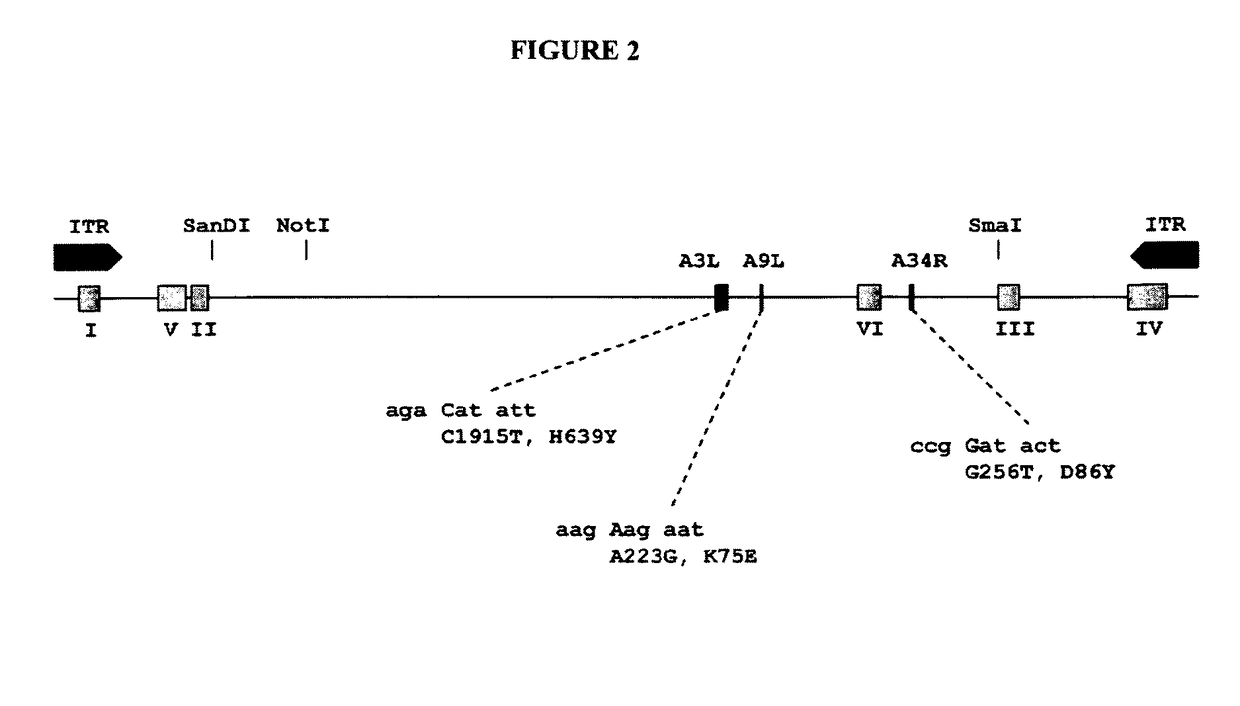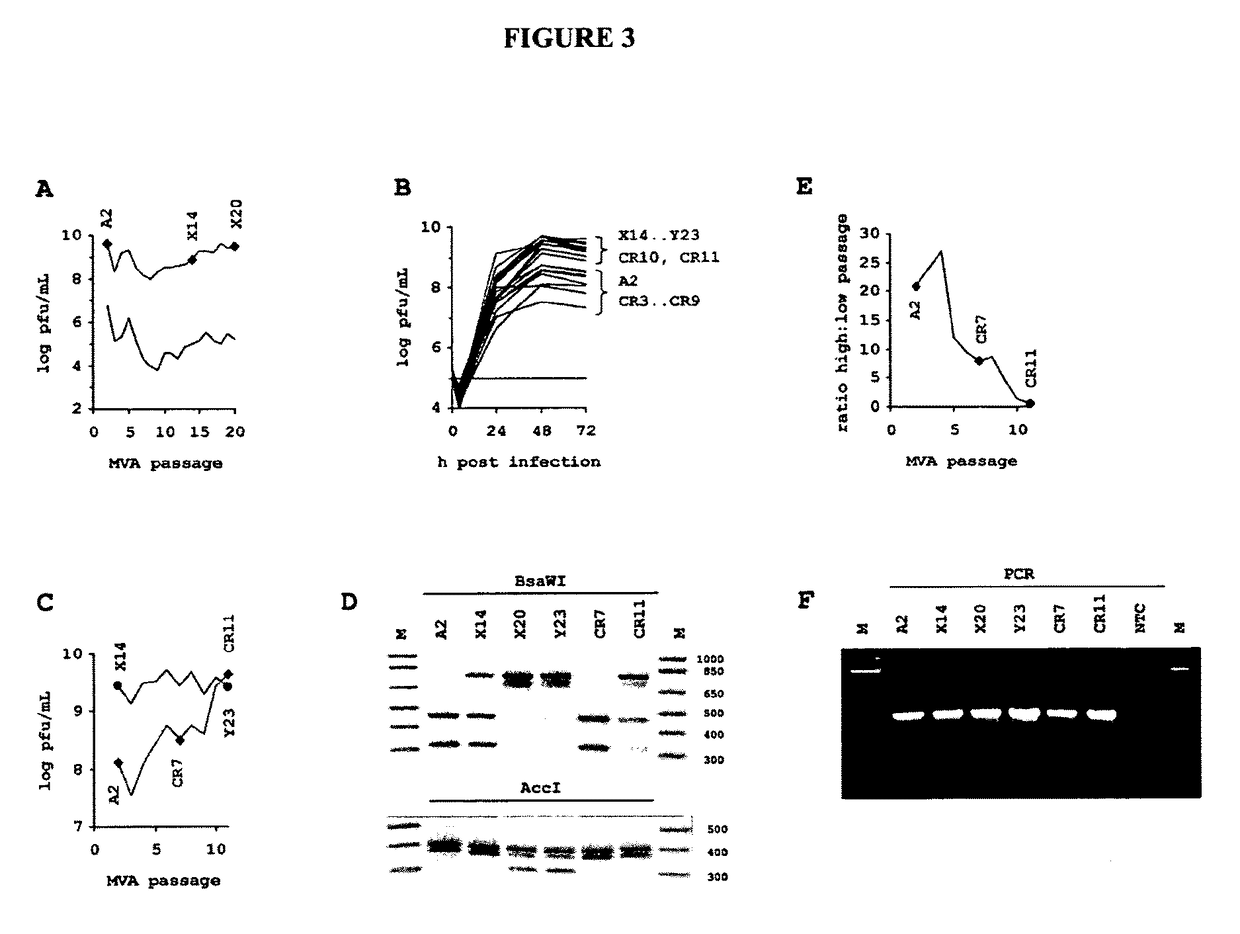MVA virus and uses thereof
a technology of mva virus and mva RNA, applied in the field of mva virus, can solve the problems of inability to raise protective or therapeutic immunity against a number of latent and chronic pathogens, inability to use replication-competent strains, and inability to successfully elicit antibody responses
- Summary
- Abstract
- Description
- Claims
- Application Information
AI Technical Summary
Benefits of technology
Problems solved by technology
Method used
Image
Examples
example 1
olates of MVA in Chemically Defined Suspension Cultures
[0288]In this example, we investigated properties of successive generations of MVA on a cell line already fully permissive for this virus. The selective environment is imposed by the chemically defined media and the absence of virion-stabilizing components such as abundant extracellular protein and lipids contained in the minimally purified lysate of embryonated eggs or bovine serum supplements commonly found in vertebrate cell cultures.
[0289]With the motivation to confirm stability expected from a DNA virus, we passaged MVA on the CR cell line. For the experiment, we used the MVA strain according to accession number AY603355 (version AY603355.1 and GI:47088326). The suspension culture and chemically defined procedure employed is fully within the constrains suggested by regulatory authorities and was developed and presented previously (Jordan, et al. 2011 in Biologicals 39, 50-58). Briefly described here, to produce hyperattenua...
example 2
g of MVA Genomic DNA
[0298]We next determined the DNA sequence of selected virus passages: 100 mL of AGE1.CR cultures at 2×10^6 cells / mL were infected with MVA at 0.01 MOI in a 1:1 mixture of CD-U3 and CD-VP4 media as described (Jordan, et al. 2011 in Biologicals 39, 50-58). 48 h post infection cells were removed by centrifugation with 200×g. Polyethylene glycol was added to 8% (from a 13% w / v stock solution in pure water) to the cleared supernatant. After incubation on ice for 30 min the suspension was centrifuged for 60 min with 6600×g and the translucent pellet containing viral particles was resuspended in 500 μL of PBS.
[0299]Extraviral DNA was digested with 8 units of Turbo DNase® (Ambion), then total DNA (predominately viral genome) was isolated with the DNA blood mini preparation kit (Qiagen®) and, both procedures according to the descriptions of the manufacturers.
[0300]To calculate expected yields: 178 kbp of MVA genome and 660 g / mol per DNA by correspond to 1.17×10^8 g of DNA...
example 3
ion Experiments
[0312]To preclude sequencing artifacts as explanation for our unexpected finding, we performed confirmation experiments. To confirm presence of MVA-CR in the preparation, we designed primers for amplification of all affected open reading frames for additional sequencing reactions. The PCR was performed with KOD HiFi® DNA polymerase (TOYOBO Novagen) 36 cycles of 20 s 55° C. annealing, 60 s 72° C. amplification (120 s for A3L), and 20 s 94° C. denaturation. The primers (f=forward and r=reverse) for amplification of the coding sequence of A9L were GCAAACGCGATAAGGATACG (a9lf) (SEQ ID NO: 19) and AAGCGGATGCAGAATAGACG (a9lr) (SEQ ID NO: 20), and of A34R were gCggAATCATCAACACTACCC (a34rf) (SEQ ID NO: 21) and TAATAACAAACgCggCgTCCATggC (a34rr) (SEQ ID NO: 22). Sequencing of the rather large A3L open reading frame was spanned with several primers: amplification was performed with GCAGAAGAACACCGCTTAGG (a3lf) (SEQ ID NO: 23) and (a3lr) (SEQ ID NO: 24), sequencing was performed wi...
PUM
| Property | Measurement | Unit |
|---|---|---|
| time | aaaaa | aaaaa |
| time | aaaaa | aaaaa |
| diameter | aaaaa | aaaaa |
Abstract
Description
Claims
Application Information
 Login to View More
Login to View More - R&D
- Intellectual Property
- Life Sciences
- Materials
- Tech Scout
- Unparalleled Data Quality
- Higher Quality Content
- 60% Fewer Hallucinations
Browse by: Latest US Patents, China's latest patents, Technical Efficacy Thesaurus, Application Domain, Technology Topic, Popular Technical Reports.
© 2025 PatSnap. All rights reserved.Legal|Privacy policy|Modern Slavery Act Transparency Statement|Sitemap|About US| Contact US: help@patsnap.com



